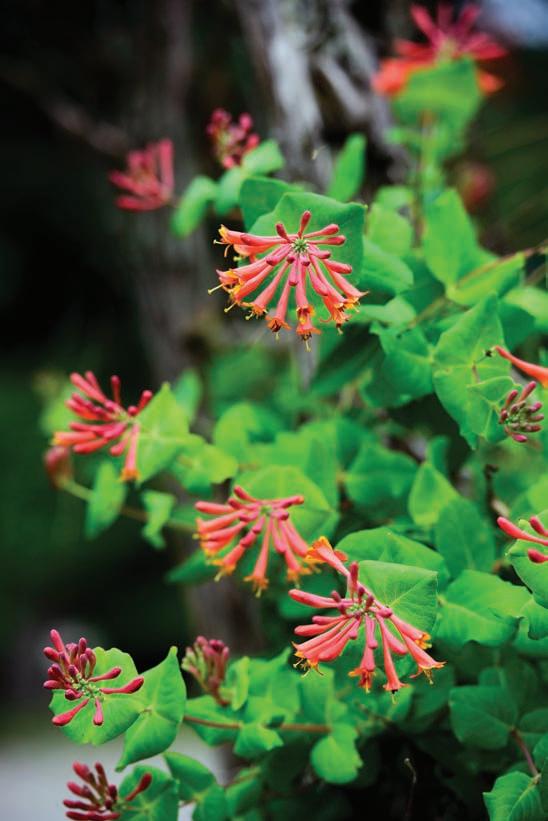
5 minute read
FEB/MARCH TIPS
BY MELINDA KOCIAN, ELLIS COUNTY MASTER GARDENERS ASSSOCIATION Ellis County Master Gardenrs Monthly Tips
FEBRUARY PLANTING • Cool-season vegetables such as broccoli, cabbage, cauliflower, kale and potatoes should be planted midmonth, or about 4 weeks prior to the average last freeze date (March 15 in Ellis County). Beets, carrots, lettuce, radishes, spinach, Swiss chard and “greens” (collard, mustard and turnip) should be planted 2 to 4 weeks prior to the average last freeze. • Plant asparagus crowns in 10-12 inches of soil. When buying crowns, look for 2-year old root systems with healthy roots. • When buying plants, biggest is not always best, especially with bare-root plants. Small to medium sizes establish faster. • Dig and divide warm-season perennials (cannas, coneflowers, perennial salvia, mums) before they break dormancy.
Advertisement
FERTILIZING AND PRUNING • Prune bush roses around Valentine’s Day. Prune old, dead and weak canes back to the ground. Leave 4 to 8 vigorous canes, removing one-half of their growth above an outward-facing bud. Wait to prune climbing or leaning roses until after they bloom. Prune errant canes any time to maintain shape. • Herbaceous perennials and ornamental grasses may be cut back now. Prune autumn sage (Salvia gregii) by 50%. Mexican feather grass does not require pruning. • Dig and divide large clumps of ornamental grasses, especially if the center of the plant has died. • Cut or mow liriope before new growth emerges. Trim Asian jasmine back to 4 or 5 inches.
GARDEN WATCH • Begin controlling insects and diseases on fruit and nut trees. Spraying is essential for a successful harvest. Contact the Texas A&M AgriLife Extension Service – Ellis County for a copy of the “Homeowners Fruit and Nut Spray Schedule”. • Look for aphids and caterpillars on vegetables, and control with insecticidal soap and Bt (Bacillus thuringiensis), respectively. • Check for scale insects adhering to the trunk, branches and leaves of hollies, euonymus, shade trees, fruit and pecan trees. Apply horticultural oil to control these and other over-wintering insects. • For the more difficult-to-control crape myrtle bark scale, apply a neonicotinoid insecticide, such as imidacloprid, as a soil drench to the root zone of infested trees.
FEATURED PLANT: • CORAL HONEYSUCKLE (Lonicera sempervirens) is also know as Evergreen Honeysuckle, Trumpet Honeysuckle or Red Honeysuckle. It is a smooth, twinning evergreen vine bearing dark shiny green leaves which are white on the lower surface. The tubular or trumpet shaped flowers occur in whorls of four to six blossoms. They are usually red outside and orange inside, or rarely all orange or yellow. Ornamentally, coral honeysuckle is well suited to climb on a fence or trellis. It is an evergreen in most of Texas and blooms sporadically throughout the growing season to attract pollinating hummingbirds.




pick one up today!


Learn more from Ellis County Master Gardeners Association at: PICK ONE UP TODAY!
MARCH
/ECMGA
PLANTING • Plant these annuals early in the month for spring color: petunias, larkspurs, foxgloves and stocks. Other annuals such as marigolds, celosia and wax begonias may be planted late in the month. • Plant tomatoes, peppers and eggplants from 4-inch pots after March 15th. Plants should be hardened off (gradually exposed to outside conditions) before putting in the ground. • Plant warm-season vegetables – beans, corn, squash, melons and cucumbers starting mid-month. • Plant herbs in raised beds with soil amended with organic matter. Harden off plants before planting. • Plant perennial flowers in amended well-drained soil. Know each plant’s prime blooming season, height, width and color to ensure season-long color. Mulch new plantings.
LAWN & GARDEN SHOW: • The Waxahachie Civic Center will be home to the 19th annual Ellis County Master Gardener’s Lawn and Garden Expo on Saturday, March 30th from 9-5pm. Exhibitors will pack the center with outdoor-living necessities, plants, machinery, yard art and landscape project materials. Shop their exhibits and they will be glad to help with your projects/questions. Adults can also attend sessions on gardening topics, or “Ask The Experts” about specific gardening challenges. The very popular Children’s Gardening Workshop will have numerous interactive displays and take-home projects. And don’t forget the Master Gardener Plant Sale with a variety of plants suited for North Central Texas landscapes. A big “Thank You” to the Expo sponsors and exhibitors for making this event possible and supporting our scholarship program.
FERTILIZING AND PRUNING • Trees, shrubs, vines and groundcovers can be fed with high-nitrogen fertilizer or compost. For patio pots and container gardens, apply a diluted, water-soluble, highnitrogen fertilizer once a week. • Remove old growth from Bermudagrass lawns by lowering mower one or two notches, allowing the grass to spread faster and choke out weeds. Bag the clippings for composting or as mulch. • Prune spring-flowering shrubs and vines such as flowering quince, azaleas, forsythia, bridal wreath (Spiraea), Lady Banksia rose and Carolina jessamine immediately after they finish blooming.

GARDEN WATCH • If frost or freeze is predicted, cover tender vegetables and annuals with frost cloth. It can make a 6 to 8-degree difference. • Beware of close-out sales on bare-root trees as survival rate is low when planted this late in the season. Spend a little more on container-grown plants. • Control black spot, powdery mildew and thrips on roses with an appropriate fungicide or systemic insecticide. Use a stream of water or insecticidal soap on aphids. • Apply pre-emergent herbicide on lawns to control broadleaf and grassy weeds if needed. A “weed and feed” fertilizer is not recommended because it is too early to fertilize lawns.














